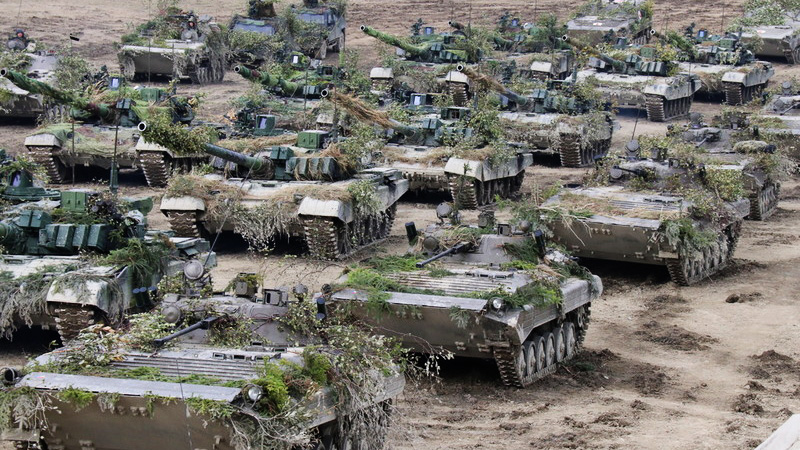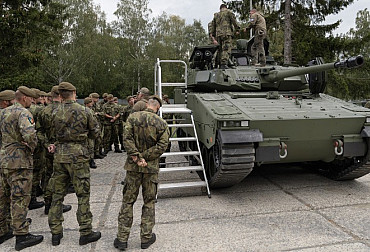Building the army needs a clear goal and a proper budget
In the light of the war in Ukraine, several things are coming into sharp focus regarding the Army, but they are not new. The Army is just a skeleton lacking muscles, as the Chief of the General Staff of the Czech Armed Forces General Aleš Opata said in the past. If we take 2 % of GDP as the minimum necessary funding for defence needs, as NATO has always meant with regard to threats, the Czech Army is underfunded at the level of 700 billion CZK. This is the difference between the 2 % of GDP level and the real budgets of the MoD since 2005. Today, the defence budget corresponds to about 1.4 % of GDP.
 Picture: If we take 2 % of GDP as the minimum necessary funding for defence needs, as it has always been meant in NATO with regard to threats, the AFSJ is underfunded at the level of 700 billion CZK. (illustration photo) | Ministry of Defence of the Czech Republic
Picture: If we take 2 % of GDP as the minimum necessary funding for defence needs, as it has always been meant in NATO with regard to threats, the AFSJ is underfunded at the level of 700 billion CZK. (illustration photo) | Ministry of Defence of the Czech Republic
Our Army looks like this - inadequately small, at least half of it not modernised, not fully functional as a whole (one compact organism) with regard to the parameters of a modern battlefield and, last but not least, roughly half of it not combat-ready due to the unavailability of equipment. All this is a logical and inevitable consequence of the long-term underfunding and uncertainty of the budgetary framework in the one-year budget system of the Czech Republic. The same consequences of underfunding are also present in other European NATO countries. Recently, for example, information has emerged about the 50 % unavailability of military equipment in the German Army, whose defence budget has been no more than 1.4 % of GDP for more than 20 years.
It seems that the current Government does indeed have the political will to return the defence budget to 2 % of GDP, but this should happen almost immediately, i.e. from 2023, and not only from 2025, as is also declared in the government's programme statement. And in that year, the Army should immediately receive at least CZK 20 billion in addition to the approved budget. Such a budgetary approach would provide the necessary budgetary stability and predictability. And this is necessary to fast-track a number of armaments and force-building projects.
Once again, voices are raised that the MoD does not have the absorptive capacity to spend the money and at the same time, often the same voices warn of the threat of unnecessary spending. Neither is necessarily true. Conceptual and rapid investment in our defense is very well possible. But we need to know where we are going, what we want and to act. The key is a holistic approach - from the identified adversary(s) and the type of war conflict(s) that threaten, we need to define by inference what we need in peacetime and in wartime to stand victorious and thus fulfil our defence interests. And we must be able to help ourselves so that eventually our allies will come to our aid - that is how the Washington Treaty is structured.
Let the US approach be a great inspiration to us and a reason to initiate intergovernmental cooperation. In 2018, the National Military Strategy was adopted, which, in light of Russia's and China's behaviour, set out the need to manage conflict with large and technologically advanced armies. This was followed by a report to Congress on the Modernization Strategy, and in 2019 the Army Modernization Strategy was adopted (the unclassified version of the strategy is available at www.army.mil). The essence is a transition from the 1981 concept of Air-Land Battle to the concept of Multi Domain Operations - land, sea, air, space, cyberspace (in the order that each domain has historically emerged). The goal is to modernize the Army (technology-weapons, force structure, command structure, size of the Army, etc.) to be able to conduct multi-domain operations in one theater by 2028 and in multiple theaters in parallel by 2035.
Although we cannot compare the US and the Czech Republic, the Czech Army must be built on the same principles and, above all, to clash with technologically advanced large armies in a multi-domain environment (the sea does not concern us). What kind of army we need - the target state - must be decided by politicians, because they then decide on the defence budget. Clearly, the Army of the Czech Republic needs to be larger for a peacetime state to play the role of a core wartime army. Given the conflict in Ukraine, we should have a peacetime army of division size - 3 combat brigades with appropriate numbers of combat support and combat support units. We are talking about about 40 thousand soldiers. The war army should have at least 100 thousand people and the peace army should be able to develop into a war army in a month (the Russian supply of equipment to the Ukrainian border lasted from December and the attack started in February). Therefore, we need about 35 thousand professional soldiers, about 30 thousand soldiers in Active Reserve and about 7 thousand soldiers performing basic military service on 3-5 year contracts in an incentive-based way, like in Sweden. In addition, there must be a functioning system of general mobilisation - liability for service applies to all persons in the Czech Republic aged 18-60.
The stated staffing levels must correspond to the numbers of modern equipment, in the peacetime army and in the reserves. And the numbers of ammunition in formations and in stocks, including smart ammunition, for at least a month of intense combat. We therefore need to urgently acquire the necessary numbers of Pandurs, TITUS, supersonics, to build back air defences capable of protecting the territory of the Czech Republic, to acquire new tracked Infantry Fighting Vehicles and to re-equip the tank army. This is just a suggestive list, which is actually much longer. The bottom line, however, is this: despite all modern technology, firepower is ultimately the decisive factor on the battlefield. We are seeing this in Ukraine.
And a key point in conclusion. It is absolutely imperative to build the C4ISTAR system (C4: command, control, communication, computers; ISTAR: Intelligence, Survailance, Target Acquisition, Recoinassance) as quickly as possible. This system is the heart and brain that will ensure the functionality of the Army as a complex organism that knows before the enemy and acts faster than the enemy. This must be matched by the acquisition of means for the collection and transmission of information, including adequately sized aircraft and drones, data fusion assets and technology, and rapid distribution of information to units, including a modern target selection system involving artificial intelligence.
The Government should urgently adopt the defence strategy and the subsequent Long-Term Defence Outlook and the Concept for the Build-up of the Armed Forces. This should become a political decision on where we are going and what we want. All these documents are not only outdated, but de facto unusable, even in the light of Ukraine. On the basis of such a goal, then, there should be no waste of budget resources, nor can it be the case that we cannot spend a budget at the level of 2 % of GDP.
The claim that we cannot invest quickly in defence capabilities because of legislation does not stand up. Law No 134/2016 needs to be corrected to fully reflect EU Directive 2009/81/es, in particular as regards the possibility to procure investment-related services (typically servicing of equipment) directly in justified cases in line with the security interest of the state. However, EU and Czech legislation allows for quick action, whether it is intergovernmental cooperation (government-to-government contracts), the possibility of directly approaching companies on the basis of the security interests of the state or on the basis of urgent operational needs (quite obvious in the light of Ukraine). We can also make much more use of the alliance agency NSPA or the EU agency EDA. Collective defence through NATO is based on prepared defence plans and necessarily on intergovernmental cooperation, which is honoured in the EU in the security and defence dimension at the level of the principle of independence and sovereignty of the Member States embodied in Article 346 of the EU Treaty and in the relevant articles in the EU directives.





















